The Apotheosis of the Urban Vigilante: Daredevil #67 and Batman #655
By Jeb D.
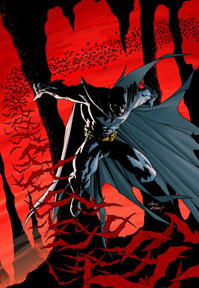 It’s a good time to be a fan of the street-level two-fisted costumed avenger. Recent creative team changes are breathing new life into two of comicdom’s toughest hombres: Batman and Daredevil.
It’s a good time to be a fan of the street-level two-fisted costumed avenger. Recent creative team changes are breathing new life into two of comicdom’s toughest hombres: Batman and Daredevil.
Daredevil, of course, has been one of Marvel’s strongest titles since Brian Bendis took it over some years back. Last year, Bendis decided it was time to move on, and Marvel recruited the “Gotham Central” team of writer Ed Brubaker and artist Michael Lark to succeed him. Bendis didn’t make things easy for his longtime pal, though—he stuck Matt (Daredevil) Murdock in jail, his secret identity virtually blown, and sat back to watch Brubaker dig his way out. Now, in issue #67, as Brubaker and Lark wrap up their first arc with the exciting conclusion to “The Devil in Cell Block D”, it’s clear that Bendis gave the new team the best launching pad they could have asked for: six issues of nail-biting suspense, engaging mysteries, and great action scenes (Lark isn’t slowed down at all by the fact that Murdock’s in prison, and out of costume). And as he’s doing with Captain
Across town at DC, there’s new beginnings for Batman, too. Of course, as Brubaker pointed out when taking the DD gig, it’s tough to work on a character like Batman, where ongoing multiple titles and miniseries mean that any one book is never more than a fraction of the character’s ongoing story. New writer Grant Morrison avoids that problem by simply ignoring it: his Batman book is, for all intents and purposes, THE Batman book, and making it gell with what’s happening in, say, Detective Comics, doesn’t seem to trouble him unduly. As he did with Seven Soldiers, Morrison can respect current continuity without enslaving himself to it.
 Morrison’s approach is similar to that of his All Star Superman book (though, of course, Frank Miller’s doing the “official” All Star Batman book): he’s taken the most familiar elements of the Bat mythos as his starting point, rather than trying to anchor things into current DC continuity. Anyone who’s ever read a Bat book will have no trouble getting into the story right away (his one concession to the current state of the DCU is that Tim Drake is Robin, but he only shows up long enough to leave on vacation, so as not to distract those of us that still think of Dick Grayson in the costume). The story builds effectively, with a nice “gotcha” introduction and the reappearance of some familiar (but not overused) faces from Batman’s past. And even if Morrison’s working fairly independently here, it’s clear that the events of this book will ripple through the various Bat books at some point.
Morrison’s approach is similar to that of his All Star Superman book (though, of course, Frank Miller’s doing the “official” All Star Batman book): he’s taken the most familiar elements of the Bat mythos as his starting point, rather than trying to anchor things into current DC continuity. Anyone who’s ever read a Bat book will have no trouble getting into the story right away (his one concession to the current state of the DCU is that Tim Drake is Robin, but he only shows up long enough to leave on vacation, so as not to distract those of us that still think of Dick Grayson in the costume). The story builds effectively, with a nice “gotcha” introduction and the reappearance of some familiar (but not overused) faces from Batman’s past. And even if Morrison’s working fairly independently here, it’s clear that the events of this book will ripple through the various Bat books at some point.
Those expecting Flex Mentallo- or Doom Patrol-style flights of fancy from Morrison will be disappointed here: this is starting out as an even more straightforward superhero book than his run on New X-Men was. As much as anything else it has the clean pacing of the classic Batman TV cartoons, with nice character moments and sharp dialog. Interestingly, this Batman reads very differently from the smug, supercilious clown of Morrison’s recent JLA Classified arc: he’s much closer to the confident, well-balanced problem-solver that was the standard before Frank Miller got his hands on him.
Inking himself, with colors from Dave Stewart, Andy Kubert’s Batman leaps off the page. He and his brother Adam recently moved to DC after having pretty well exhausted their take on the Marvel stable, and the sense of renewal is palpable. Where the brilliant J.H. Williams’ work on Detective Comics felt a bit showy, and not well-suited to Paul Dini’s story, Kubert here is clearly on Morrison’s wavelength: I’d be willing to bet both of these guys harbor more love for the colorful craziness of the Adam West TV series than most creators will admit. The wild action that opens the book (even if it reads a bit oddly in retrospect) signals that there’s plenty of old-fashioned throwdowns ahead.
There is one odd note to the art, though: the London scene where Bruce Wayne encounters Dr. Kirk (Man-Bat) Langstrom looks like a deliberate homage to Butch Guice’s stunning work on Ruse (at times, Wayne’s a dead ringer for Simon Archard). An interesting, if slightly distracting, choice.
I have to admit that I burned out on Batman some time ago, and it takes something pretty special to grab my interest. Batman #655 signals the beginning of something special: it’s a big, colorful Batman story that will feature villainy, dark secrets, damsels in distress, over-the-top action, and a Batman who’s smart, tough, and in control of himself. These days, that’s nothing to sneeze at.
Though corporate bad blood scotched the recent idea for a Bendis-Brubaker crossover between Daredevil and Batman, fans of both characters can console themselves with some of the best comics either of these spandexed tough guys have ever appeared in.
RATING: 
Return of the… It’s Good to Be… Sorry, I’m Outta “King” Jokes. Here’s Jack Kirby’s Galactic Bounty Hunters
By Jeb D.
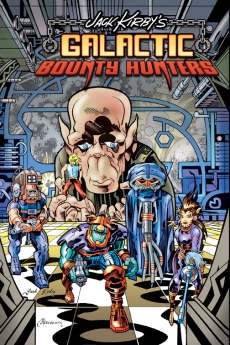 This new series from Marvel’s creator-owned Icon imprint represents the reconstruction of some characters and ideas left unfinished at the death of legendary comic artist Jack “King” Kirby. It’s an important project on at least a few levels.
This new series from Marvel’s creator-owned Icon imprint represents the reconstruction of some characters and ideas left unfinished at the death of legendary comic artist Jack “King” Kirby. It’s an important project on at least a few levels.
The first level is as a labor of love. Like many children of famous parents, Lisa Kirby grew up knowing little of her father’s work, and with no sense at all of his stature in the world of comics. Since his death, she’s come to appreciate his vast contributions, and devoted herself to the preservation of his memory. Some years back, she came across a set of characters that Kirby had intended to use in his short-lived Captain Victory series, but set aside for a later use that he didn’t live to see. Lisa Kirby has spent the better part of a decade reconstructing and creating this story with some of Kirby’s longtime friends and collaborators, including penciller Mike Thibodeaux, Kirby’s one-time agent, who, following an accident to his right hand, learned to draw left-handed to complete the project! Labor of love and then some. The result is a book steeped in devotion to the engagingly mad worlds that Kirby created.
The second level is the significance of this project in continuing the thaw in relations between Kirby’s estate and Marvel Comics. It’s no secret that Kirby left the company on unfriendly terms, eventually returned to find his new work in less demand, and ultimately left again, suing for return of his original artwork. That was many generations of Marvel ownership and management ago, and the current regime seems to be working hard to provide a top-notch outlet for this project. The Icon book is glossy and bright, with a cardstock cover, and the modern coloring means that it lacks the garishness that can accompany high-gloss reprints of Kirby’s earlier work. And your $3.99 buys you fifty pages of story (and no ads save for a couple for Kirby books and merchandise), which isn’t bad. And, evidently, the Kirby estate will be compensated at a page rate equivalent to that of today’s top artists, to reflect Kirby’s place in the industry. Marvel has done well by the King with their packaging of the book.
But, then, there’s that third level: the comic itself. The fact is, for better or worse, it reads a lot like a Jack Kirby comic. It’s hardly news that The King had a tin ear for dialog, and his successors make a virtue of necessity by coming up with the kind of groaners that always had Kirby fans gritting their teeth (“Enjoy this moment while it lasts, Bounty Hunters! My offspring will soon free me and DESTROY you all!”). Lisa Kirby had never written a comic before, and co-writer Steve Robertson doesn’t do anything to temper her taste for over-the-top dialog. Readers who tend to skim over such details will find it easier to take than those who need a strong script to hold their interest.
Our protagonist, Jack Berkeley, is a superhero artist who also happens to be (whoda thunk?) a superhero! And because his identity is a secret, his son Garrett finds himself resenting the danger-shirking fuddy-duddy he believes his father to be (Garrett wants the excitement of a career as a stage magician). It’s not much of a spoiler to say that Garrett finds himself inadvertently drawn into his father fantastic real-life adventures. It would be nice if the characterization or dialog rose above the predictability of the basic plot (which is the formula for good superhero comics); unfortunately, Jack and Garrett don’t have a lot in the way of depth, and Jack’s wife Rose (Kirby’s wife, by the way, was named Roz) is little more than the strong, supportive helpmeet of the sort that every good action hero needs. With offspring who need a wake-up call to appreciate their father’s importance, you can’t help but read a touching bit of history into the story (and could there be something of a jibe at one-time Kirby disciple Jim Steranko in the character of Garrett?), even if the actual events aren’t exactly compelling.
And the art? Thibodeaux, along with Karl Kesel and Scott Hanna, incorporates original Kirby pencils with their own, producing something that is less a slavish Godland-style homage than the sort of Kirby-inspired old-school stylings of an Erik Larsen or Paul Pelletier. It’s instantly recognizable as Kirby, but with a fluidity that will appeal to modern audiences who have trouble with the big blocky character of much of Kirby’s work.
There are some nice modern touches that ring with the feel of Kirby: Heebie and Jeebie, the living computer viruses, are exactly the kind of thing Kirby would have made of the Internet; and the villainous Ma Slugg receives communication via carrier pigeon on paper scrolls, making them impervious to digital eavesdropping. Ma Slugg herself, like many of the characters, is a colorful visual treat, a scaly monster in bingo-lady drag.
Anyone who’s a longtime fan of Jack Kirby will certainly want to check out this first issue. I rather doubt the story will keep most readers coming back for more, but the heartfelt tribute at its core makes up for a lot of failings.
RATING: 
They’re Back? I Didn’t Know They Were Gone! Agents of Atlas #1
By Jeb D.
 I’m not sure that the Marvel Universe needs any new superhero teams, but I suppose I can understand their wanting to emulate DC by dredging up some forgotten Golden Age heroes for a bit of modern-day “fish-out-of-water” fun. Interman creator Jeff Parker, currently writing Marvel’s new all-ages Avengers title, brings us a brisk setup story as we meet such characters as Gorilla Man (interestingly, only one of several characters by that name once published by Marvel’s predecessor, the Timely/Atlas company), the original Marvel Boy, the robot M-11, and Venus, whose power is to stop men in her tracks with her beauty (you’d think every superteam would have one of those). And it’s not every comic book that features appearances by Dwight Eisenhower AND Dum-Dum Dugan.
I’m not sure that the Marvel Universe needs any new superhero teams, but I suppose I can understand their wanting to emulate DC by dredging up some forgotten Golden Age heroes for a bit of modern-day “fish-out-of-water” fun. Interman creator Jeff Parker, currently writing Marvel’s new all-ages Avengers title, brings us a brisk setup story as we meet such characters as Gorilla Man (interestingly, only one of several characters by that name once published by Marvel’s predecessor, the Timely/Atlas company), the original Marvel Boy, the robot M-11, and Venus, whose power is to stop men in her tracks with her beauty (you’d think every superteam would have one of those). And it’s not every comic book that features appearances by Dwight Eisenhower AND Dum-Dum Dugan.
The feel of the book is somewhere between Planetary and Alan Moore/Peter Hogan’s Terra Obscura, as this team is evidently going to be investigating secrets that lie deep beneath the foundations of the Marvel Universe (Marvel’s hinted as much by publicizing the book with such devices as an online scavenger hunt for clues).
Artist Leonard Kirk goes for a sketchy Golden Age feel that hits the proper nostalgia quotient, but without the striking visuals that artists like Chris Sprouse or Yannick Paquette have brought to similar material. It gets the job done, but won’t have you ooh-ing and aah-ing.
I really don’t have anything bad to say about this comic, beyond the fact that while it doesn’t exactly feel “padded” (certainly a lot goes on, and there’s plenty of action), it’s clear that we’re at least one issue away from knowing if the main story will be worth following. Probably a good trade-waiting choice, to see how things pan out.
RATING: 
![]()

Wonder Woman:
DC Comics
by Graig
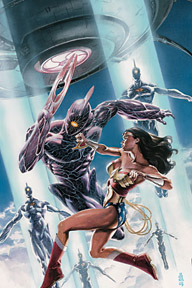 I’m finding it very difficult to be disappointed in the finale to Greg Rucka’s run on Wonder Woman. While I regret the fact that in this final trade his sub-plot involving Veronica Cale (a character Rucka was establishing as Diana’s corporate nemesis, ala Lex Luthor and Superman, in the first two collected editions of his run) is relegated to three pages without coming to any satisfactory resolution to the arc, what he got up to with the Amazing Amazon in Mission’s End is in equal parts pulse-pounding and heart-wrenching.
I’m finding it very difficult to be disappointed in the finale to Greg Rucka’s run on Wonder Woman. While I regret the fact that in this final trade his sub-plot involving Veronica Cale (a character Rucka was establishing as Diana’s corporate nemesis, ala Lex Luthor and Superman, in the first two collected editions of his run) is relegated to three pages without coming to any satisfactory resolution to the arc, what he got up to with the Amazing Amazon in Mission’s End is in equal parts pulse-pounding and heart-wrenching.
While the Gods still toy with the Amazons under Diana’s nose, she’s got her own troubles to worry about, since Maxwell Lord has control of Superman’s mind, and therefore his body, and there’s only one solution that can stop her friend from destroying the world. I’m sure we all know what that solution is by now, since it kick-started much of the Infinite Crisis, and as a result of her actions, Diana’s now vilified in the press and the eyes of the people, including many of her friends and contemporaries. Meanwhile, her actions have also set the OMACs on Paradise Island with the intention of obliterating it and its people. Things hardly get better.
Rucka crafts one insanely powerful moment after another, any one of which would decimate a normal person to their core, but Diana is Wonder Woman for a reason, and I don’t think there’s another writer out there who has handled her with all the grace, poise, dignity, strength, confidence and beauty that Rucka has. In every situation Rucka brings forth, Diana stays true to both her warrior’s heritage and her mission of peace and unification of man.
Accompanied by a bevy of artist, including Cliff Richards, Rags Morales, Ron Randall and more, this final trade is a mite inconsistent in the art department, but the strength of the storytelling holds up. Though a few of the stories Rucka had hoped to tell (including a sub-plot involving Ares and his child as well as the aforementioned Cale storyline) were completely waylaid by the Infinite Crisis, the corporate interference allowed for some particularly meaty drama (Diana and Batman in “Affirmative Defence” or the intense Amazon battle against the OMACs in “Marathon”) which more than compensated. Allan Heinberg has some big, high-heeled boots to fill.
RATING: 
The R. Crumb Handbook
MQ Publications Ltd.
By Elgin Carver
 In the 1960s there came into existence (exactly where and exactly when is still an item of dispute among scholars) a new genre of comic books generally referred to as "underground comix". Distinguished far more often than not by images that are pornographic by almost anyone’s standards and/or violent in the extreme, they seemed to be a sign that the culture was undergoing a basic alteration from the ground up. The most innocent form of entertainment was being taken over by people that no longer felt there was anything left in the culture worth preserving. Without argument the most influential artist in this category of books is Robert Crumb.
In the 1960s there came into existence (exactly where and exactly when is still an item of dispute among scholars) a new genre of comic books generally referred to as "underground comix". Distinguished far more often than not by images that are pornographic by almost anyone’s standards and/or violent in the extreme, they seemed to be a sign that the culture was undergoing a basic alteration from the ground up. The most innocent form of entertainment was being taken over by people that no longer felt there was anything left in the culture worth preserving. Without argument the most influential artist in this category of books is Robert Crumb.
Crumb became the instant master of self-revelatory, unblinkingly autobiographical analysis of the darker side of one’s own psychosis. Taken at the time as commentary on society and cultural satire, and doubtless some such content is involved, Crumb became the one true celebrity among this art movement. In fact he may be the best known comic book artist in the world today with an astounding continual flow of work, exhibits in important museums and galleries in places like Paris, New York, Germany, and Philadelphia, an ongoing complete reprint of not just all of his published work but his sketchbooks as well, and a documentary of his life entitled Crumb.
This chunky 400 plus page book is a general retelling of his life by Crumb, illustrated by large numbers of images from work throughout his career to date. It is a reasonably good introduction for anyone not familiar with his work. As always it is an embarrassingly honest (from his point of view) and candid story. Included is a CD of music from several groups he has performed with, Crumb being a big fan and collector of early 78s.
Without Crumb, it is possible that books like Blankets or even A History Of Violence would never have come about. Yet once one becomes aware of his true personality and character, his work becomes more disturbing than entertaining, more pitiful than revealing. A far more insightful view of the man is available in the previously mentioned documentary. Be warned that if you admire his work, this movie will demonstrate in a very clear manner that what seemed like social commentary and cultural insight is in reality the work of a person brought up in a dysfunctional family. His father suffered from battle fatigue in World War II, his mother from some undisclosed mental disturbance, and his brothers both clearly suffer from their situation more than Crumb, even more so as they age but remain major influences from youth onward. Couple this with a massively disturbing LSD trip which left Crumb helpless and sick for six months and admittedly bizarre sexual desires, he is clearly delineated as a person whose work you may enjoy and find enlightening but would probably not want to spend much time with. If the movie cannot be found this book is a reasonable alternative.
RATING: 
Kafka TPB
Active Images
by Graig Kent
 Even if you aren’t overtly familiar with his works, if someone says simply “Kafka”, it’ll likely elicit thoughts of surrealistic isolation, torment, conspiratorial paranoia, or complex and seemingly illogical thoughts or actions. “Kafkaesque” didn’t become an adjective for nothing.
Even if you aren’t overtly familiar with his works, if someone says simply “Kafka”, it’ll likely elicit thoughts of surrealistic isolation, torment, conspiratorial paranoia, or complex and seemingly illogical thoughts or actions. “Kafkaesque” didn’t become an adjective for nothing.
Steven T. Seagle and Stefano Gaudiano’s first printed work is collected again for the first time in over a decade, and though it bears the same name as the legendary Czech novelist, Seagle actually titled it after the arcane and virtually extinct word “kafka”, meaning vanished or taken. The story of a man who has been separated from his life, his wife and everything he knows, and put into protective custody with a new identity certainly fits along that line. But wisely realizing that the common reference of the word relates to the printed works of Franz Kafka, Seagle infused many Kafkaesque components, including elements of the fantastic (Dan Hutton, the protagonist, has some minimal psychic abilities), complex and secretive government departments, and a sense of frantic immediacy that stunts the character from seeing the larger picture beyond his own predicament.
Hutton, in the story, has his second life turned upside-down when two sets of government agents arrive at his door within minutes of each other, both alerting him to the fact that his new identity has been blown and that they must be allowed to escort him back to CIA headquarters. Escaping both groups of men, Hutton finds his own way back, with a little aid from his special abilities, only to find that all records about him have either been deleted or never existed in the first place, leaving Hutton to question his own reality.
For a first effort, Kafka is to be applauded (especially considering the deadline constraints under which the book was produced in the 1980’s, as detailed in an interview published in the back of the collection), and in fact was nominated for an Eisner, but losing to the Watchmen in the Best Limited Series category. The art by Gaudiano is stripped down, almost storyboard-like in its simplicity, seemingly free of shadows but made up for by use of heavy line. It’s not very striking visually, but it oddly does serve the story appropriately.
There’s an 80’s naivety to Kafka, like comparing a crime drama from today to one of 20 years ago, the public’s awareness of and exposure to the inside world of intelligence, investigation, politics, legislation etc. is so much greater these day than it ever was, and the surprising twists laid down in the book are kind of hindered by that. Yet, it holds up as a good read, despite its age and the novice effort of its creators.
RATING: 
![]()

 Detective Comics #822 (DC) – Paul Dini continues his reign on “Detective Comics,” this time with an adventure involving the Riddler – but not as the villain. There’s been a murder in Gotham and, for some unknown reason, the Riddler has decided to play private eye in order to exonerate Bruce Wayne of the crime. Batman gets involved and the two clue-hounds go head-to-head to break the case. While the mystery-plot itself – a socialite likely murdered by a hothead with a rap sheet – has little more depth than a “Silk Stalkings” episode, the interesting pairing of Riddler and Batman is enough to lift this issue. Unlike more recent portrayals of the Riddler as a comic bumbler (see: “Catwoman: When in Rome”), this is the Riddler that Dini used in “Batman: The Animated Series” – smart, cunning and full of hatred for the World’s Greatest Detective. Not a perfect issue, but it should certainly be interesting seeing what else Dini has up his sleeve. – Mark
Detective Comics #822 (DC) – Paul Dini continues his reign on “Detective Comics,” this time with an adventure involving the Riddler – but not as the villain. There’s been a murder in Gotham and, for some unknown reason, the Riddler has decided to play private eye in order to exonerate Bruce Wayne of the crime. Batman gets involved and the two clue-hounds go head-to-head to break the case. While the mystery-plot itself – a socialite likely murdered by a hothead with a rap sheet – has little more depth than a “Silk Stalkings” episode, the interesting pairing of Riddler and Batman is enough to lift this issue. Unlike more recent portrayals of the Riddler as a comic bumbler (see: “Catwoman: When in Rome”), this is the Riddler that Dini used in “Batman: The Animated Series” – smart, cunning and full of hatred for the World’s Greatest Detective. Not a perfect issue, but it should certainly be interesting seeing what else Dini has up his sleeve. – Mark
RATING: 
 Wormwood: Gentleman Corpse #1 (IDW) – After a startlingly good issue #0, issue #1 of writer/artist Ben Templesmith’s “Wormwood: Gentleman Corpse” doesn’t have the same level of wit and humor as its predecessor, which is unfortunate. Here, Wormwood recruits a female assistant – Phoebe – to accompany himself and Pendulum on their monster-dispatching missions. As the Cthulu-meets-“Aliens” adventure unfolds, at one point a different monster comes to tear apart Wormwood for killing his mother and we’re allowed a taste of Phoebe’s powers, which seem to erupt from a red, winged tattoo on her chest. Perhaps the humor of #0 was just a part of that issue and, for the most part, “Wormwood” will be a “Fell”-looking investigative horror book with a quirky lead who occasionally makes with the witticisms and some hilariously over-the-top monster art. If so, great, but one’s expectations should be held a little bit more in check after issues #0. – Mark
Wormwood: Gentleman Corpse #1 (IDW) – After a startlingly good issue #0, issue #1 of writer/artist Ben Templesmith’s “Wormwood: Gentleman Corpse” doesn’t have the same level of wit and humor as its predecessor, which is unfortunate. Here, Wormwood recruits a female assistant – Phoebe – to accompany himself and Pendulum on their monster-dispatching missions. As the Cthulu-meets-“Aliens” adventure unfolds, at one point a different monster comes to tear apart Wormwood for killing his mother and we’re allowed a taste of Phoebe’s powers, which seem to erupt from a red, winged tattoo on her chest. Perhaps the humor of #0 was just a part of that issue and, for the most part, “Wormwood” will be a “Fell”-looking investigative horror book with a quirky lead who occasionally makes with the witticisms and some hilariously over-the-top monster art. If so, great, but one’s expectations should be held a little bit more in check after issues #0. – Mark
RATING: 
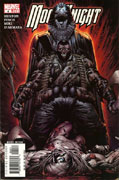 Moon Knight #4 (Marvel) – Boy, and you thought Marvel Zombies was the gross-out book of the year. What’s taking this comic a step beyond previous MK series is the career-best art by David Finch. He’s much better with the quiet moments than he’s shown in the past, with expressive close-ups and interesting paneling. More to the point, he’s making the book’s violence so visceral you continually wonder that it’s not being released as a MAX title. No slouch himself, novelist Charlie Huston is taking to this comic-book writing gig like a natural, as he continues the rehabilitation of Marc Spector with ghosts of the past (and present) and shows off with several different narrative voices, all leading up to the series’ best cliff-hanger yet. Fortunately, it looks as thought the initial story arc will be completed before the scheduled Civil War tie-in and inevitable Spider-Man guest appearance. While I’m hoping that Marvel has enough sense not to mess with this striking series, it wouldn’t be the first time. Grab this one while it’s still fresh and bloody. – Jeb D.
Moon Knight #4 (Marvel) – Boy, and you thought Marvel Zombies was the gross-out book of the year. What’s taking this comic a step beyond previous MK series is the career-best art by David Finch. He’s much better with the quiet moments than he’s shown in the past, with expressive close-ups and interesting paneling. More to the point, he’s making the book’s violence so visceral you continually wonder that it’s not being released as a MAX title. No slouch himself, novelist Charlie Huston is taking to this comic-book writing gig like a natural, as he continues the rehabilitation of Marc Spector with ghosts of the past (and present) and shows off with several different narrative voices, all leading up to the series’ best cliff-hanger yet. Fortunately, it looks as thought the initial story arc will be completed before the scheduled Civil War tie-in and inevitable Spider-Man guest appearance. While I’m hoping that Marvel has enough sense not to mess with this striking series, it wouldn’t be the first time. Grab this one while it’s still fresh and bloody. – Jeb D.
RATING: 
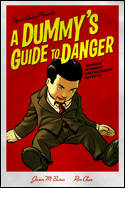 A Dummy’s Guide to Danger #1 (Viper Comics) – This is a very strange indie, but also a pretty inspired one. Like the inverse of the villain Scarface/the Ventriloquist in the “Batman” universe, “A Dummy’s Guide to Danger” involves a crime-fighting ventriloquist (Alan Sirios) and his dummy (Mr. Bloomberg) who comes across as his own distinct personality, though it’s more likely that Alan just has a screw loose. But, the two of them make for a formidable team, so no one’s really complaining. In the first issue, there’s a serial killer on the loose targeting celebrity starlets and it gets really bloody, really fast. The somewhat whimsical and cartoony art from Ron Chan works even that much more when there’s a particularly graphic bit of gore (jeez, that last panel is fucked up!) as it constantly subverts the readers’ expectations. A good, solid caper book that’s probably going to get a lot weirder before anything’s explained (issue #1 just drops you right into the oddball Alan-Mr. Bloomberg relationship without any hint of origin, expecting the reader to just dive in – sink or swim – and rightly so). Kudos to Chan and writer Jason Burns. – Mark
A Dummy’s Guide to Danger #1 (Viper Comics) – This is a very strange indie, but also a pretty inspired one. Like the inverse of the villain Scarface/the Ventriloquist in the “Batman” universe, “A Dummy’s Guide to Danger” involves a crime-fighting ventriloquist (Alan Sirios) and his dummy (Mr. Bloomberg) who comes across as his own distinct personality, though it’s more likely that Alan just has a screw loose. But, the two of them make for a formidable team, so no one’s really complaining. In the first issue, there’s a serial killer on the loose targeting celebrity starlets and it gets really bloody, really fast. The somewhat whimsical and cartoony art from Ron Chan works even that much more when there’s a particularly graphic bit of gore (jeez, that last panel is fucked up!) as it constantly subverts the readers’ expectations. A good, solid caper book that’s probably going to get a lot weirder before anything’s explained (issue #1 just drops you right into the oddball Alan-Mr. Bloomberg relationship without any hint of origin, expecting the reader to just dive in – sink or swim – and rightly so). Kudos to Chan and writer Jason Burns. – Mark
RATING: 
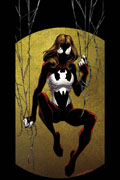 Ultimate Spider-Man #98 (Marvel) Given that this title is often taken for granted (having the same creative team for nearly 100 issues and counting will do that), it’s actually been somewhat inconsistent recently: the Spidey-Kitty Pryde pairing was a good one, but the Ultimate Deadpool arc seemed forced, and the Blade/Morbius story was over almost before it began. Now, of course, just to trip us up, Bendis takes on the one story that fans have been dreading (“Ultimate Clone Saga”) and whips up his best Spidey tale in a couple of years. Last issue, Spider-Man faced off against a Scorpion-like supervillian, who, unmasked, turned out to be… Peter Parker? This issue, he takes his unconscious foe to be examined by the only person he knows who might be able to discreetly provide answers to something so bizarre: Reed Richards of the Fantastic Four. There’s great dialog, alternating good jokes with Peter’s mounting sense of panic when he returns home to find that Mary Jane is missing. Bendis throws in a couple of plot twists we did
Ultimate Spider-Man #98 (Marvel) Given that this title is often taken for granted (having the same creative team for nearly 100 issues and counting will do that), it’s actually been somewhat inconsistent recently: the Spidey-Kitty Pryde pairing was a good one, but the Ultimate Deadpool arc seemed forced, and the Blade/Morbius story was over almost before it began. Now, of course, just to trip us up, Bendis takes on the one story that fans have been dreading (“Ultimate Clone Saga”) and whips up his best Spidey tale in a couple of years. Last issue, Spider-Man faced off against a Scorpion-like supervillian, who, unmasked, turned out to be… Peter Parker? This issue, he takes his unconscious foe to be examined by the only person he knows who might be able to discreetly provide answers to something so bizarre: Reed Richards of the Fantastic Four. There’s great dialog, alternating good jokes with Peter’s mounting sense of panic when he returns home to find that Mary Jane is missing. Bendis throws in a couple of plot twists we did